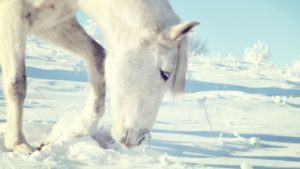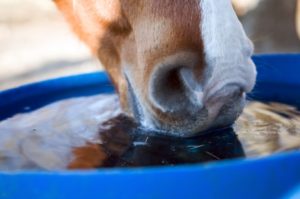Snow is not water.
Sure, it is the frozen equivalent. But when it comes to proper hydration for your equines, snow does not come close to fulfilling their needs.
 “Absolutely true,” said Dr. Janelle Tirrell, of Third Coast Equine, when I mentioned that eating snow did not provide enough hydration for horses. She attributes inadequate water availability to the uptick in colic cases during the winter months. During especially cold snaps, she says colic calls to Maine farms can nearly triple.
“Absolutely true,” said Dr. Janelle Tirrell, of Third Coast Equine, when I mentioned that eating snow did not provide enough hydration for horses. She attributes inadequate water availability to the uptick in colic cases during the winter months. During especially cold snaps, she says colic calls to Maine farms can nearly triple.
Dr. Jeff Warren of Southwest Veterinary Service in Durango, Colorado, agrees: “Trusting in snow to provide adequate hydration is just not right. It’s our job as caretakers of livestock that we not do it that way,” he said. “I treat lots of colic because the clients’ horses are not adequately hydrated.”
 Of course, horses tend to drink less during winter. But that doesn’t mean we can neglect water duty. It’s still essential. Providing salt is, too, and doing so often encourages them to drink.
Of course, horses tend to drink less during winter. But that doesn’t mean we can neglect water duty. It’s still essential. Providing salt is, too, and doing so often encourages them to drink.
Some additional Do’s and Don’t’s:
- Do use a water heater or provide some way for horses to have 24-hour access to unfrozen water.
- Do provide free-choice salt.
- Don’t force salt or electrolytes on a horse who’s already dehydrated. It may exasperate the problem.
- Do offer warm water, especially to older or more vulnerable horses. (Years ago, I offered a regular bucket of warm water to my aging mare. While she didn’t drink from the standard, barely unfrozen bucket, she would drink warm water every night as if it were a cup of hot cocoa. Helping or enabling – you be the judge.)
- Do offer occasional bran mashes (bran mixed with lots of warm water). Or, if you are feeding grain, consider soaking it in warm water instead of giving it dry.
Dr. Warren likes to offer warm water mixed with mineral oil to horses at risk of colic. He uses a 1:1 ratio (for example, a half gallon of each). “When they’re feeling crummy, it makes them feel more comfortable.”
In the interest of keeping colic at bay, I like to encourage horse owners to decrease grain intake and increase hay intake, especially during winter months. Read more about colic here.
Willis Lamm shared another insight: lacking a reliable water source, horses may discover dangerous water sources like melted water under cattle guards. Can you think of any scenario less ideal? Check out the specifics of his involved rescue here.

Perhaps some of the misunderstanding comes from observing feral/wild range horses. They will proceed in droves to snow banks for water. However when one takes a closer look, they seek the margins, typically on south-facing aspects, where the snow is melting and pooling in small pockets and crevices. From a distance it appears as if they are eating snow. I would state that generally they aren’t.
Also, with free-access salt such as using stock blocks, some horses prefer trace mineral blocks and shun the others and some horses only want “white” salt. It might pay to experiment with small blocks to see what your horses will willingly lick before investing in the 50 pounders.
And certainly automatic deicers that keep the water closer to 40 degrees helps encourage voluntary water consumption.